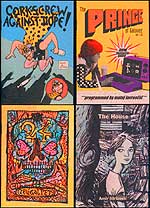 "Stripburger" #28
"Stripburger" #28 |
"Stripburger" #28 brings out the child in you. A tactile delight, you start by rubbing your hand over the ribbed cardboard tube that wraps around the box like the cozies they put around your morning coffee cup. Small squares and circles have been handcut into the cardboard, so creatures underneath can peek out the windows. Slip it off and you see the inner jacket that forms the small, four and half by six-inch box. It unfurls completely into a bright pink, blue and yellow abstraction on one side and a black and white checkerboard on the other. Like a present, you unwrap it with excitement until, unexpectedly, the contents come pouring into your lap — twelve individual "mini" comix, each with their own color cover, and each by a different artist.
 Four of the twelve minicomix found inside "Stripburger" #28
Four of the twelve minicomix found inside "Stripburger" #28 |
Adding to the exoticism, "Stripburger" originates in Slovenia and the contributing artists form a mini-Balkans with representatives from Slovenia, Bosnia, Serbia, Italy, France and England. (All the works are in English.) Not surprisingly the comix themselves are as unconventional as their package. One book has been designed to look like screen shots of a lost Atari 2600 video game about a prince and an onion-soup-loving demon. Andrej Stular's "Hole" has a single panel per page — an inky, scratchy image of urban grief accompanied by a word or phrase that may or may not connect to the next page. Most of the works follow absurd or dreamlike structures. It seems to be part of the psyche out there. Furthermore these artists' display broader graphical influences than most American cartoonists. Americans tend to use other cartoonists for inspiration, but these works put themselves in the context of the larger modernist and surrealist fine art movements. Only a few read like "regular" comix.
 "Non" #5
"Non" #5 |
"Non" #5 comes from California's Red Ink Press. Like the East Coast's Highwater Books, with which it has an affiliation, Red Ink amounts to one guy, Jordan Crane, who has discovered the gospel of high-end, handcrafted comicbooks. This issue's silk-screened cover wraps completely around and under the nearly two-inch thick contents. When completely unfolded it turns into a 30-inch long pink and yellow panorama. Underneath the cover sits a thick book with a simple, geometrical patterned cover. Pick it up and you discover underneath, nestled in a cutout hollow of thick cardboard, a smaller book! Then, underneath that, another book hidden away! Three books where you expected only one.
 Peek-a-boo! What's hiding under the covers of "Non?"
Peek-a-boo! What's hiding under the covers of "Non?" |
The larger book contains an anthology of short stories that would be more than satisfactory on its own. Beautifully printed using a brick-colored ink on soft, matte, off-white paper, the lines are razor sharp. Some contributors also use a single highlight color of pink or blue or yellow. The mono-named Jason begins the book with a simply-drawn parable of death as a lonely houseguest whose hosts keep dying. Following that are a variety of humorous, often open-ended stories by Brian Biggs, Megan Kelso, Paul Pope and about twenty others. Each of the smaller books contains a single story, one by Jordan Crane, the other, wordless, by Kurt Wolfgang.
The delightful comic packages of "Non" #5 and "Stripburger" #28 both challenge and reaffirm the comix medium. Most traditional comicbooks look cheap and lousy in the comparison to these complex wonders. Yet at the same time the careful, delicate constructions of these comicboxes imbue the dignity and preciousness of treasure to this traditionally disposable art form.
Sadly both these books will be hard to get. "Stripburger" #28 may be found at extremely intelligent comicbook stores, and perhaps through the Top Shelf Comics website. "Non" #5 has not been shipped to stores yet since all 2000 copies must be handmade. You can order it by emailing the publisher: jordan@beat.com.
